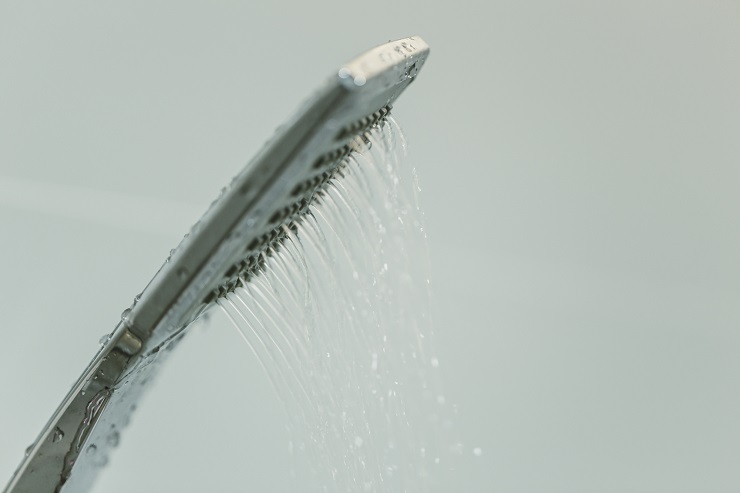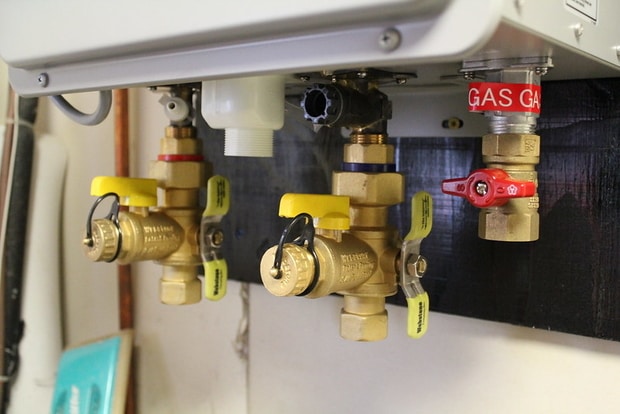Is your shower pressure more of a drip than a downpour?
Low water pressure is a common household woe, but it doesn’t have to be a permanent problem.
Discover what causes low water pressure in the shower and how you can fix this issue yourself, before you resort to calling a plumber.

What Causes Low Water Pressure in the Shower?
Low water pressure can stem from a variety of sources.
It might be the showerhead, the water heater, the pipes, or even the valves.
Sometimes, it’s a mix of several factors.
To effectively tackle the problem, it’s crucial to get familiar with all the potential culprits.
Here are the six most common reasons behind low water pressure in the shower.
1. Blocked Showerhead
A common reason behind low water pressure is often right under your nose – or, more accurately, right above your head in the shower.
If the water pressure is fine throughout the rest of your house but your shower is lacking, chances are your showerhead is blocked.
Over time, showerheads can get clogged, typically due to mineral buildup and limescale.
2. Mineral Deposits
If you live in an older house, there is a possibility that you have outdated plumbing systems.
Usually, older galvanized pipes are more susceptible to mineral accumulation.
This means that over time, the mineral deposits accumulate and clog your pipes.
This then causes low water pressure in your shower and faucets.
3. Water-Saving Showerhead
Water-saving showerheads are becoming common due to federal regulations.
Newer showerheads have a limited flow rate of only up to 2.5 gallons per minute, with a water pressure of only 80 pounds per square inch.
Although water-saving showerheads can cut your heating costs and decrease water consumption, they tend to create low water pressure.
4. Home Water Valves Are Shutoff
When your shower suddenly has low pressure, it might be caused by an accidental shutoff of your house’s water valves.
These valves are the main controls of the water that goes into your home and is usually found in the water meter box.
An accidental or even a slightly off position of your water valves can affect the water pressure in your home.
5. Leaking Water Main
Cracks or leaks to your water main can also cause low water pressure in the shower.
Your main water line is also susceptible to ruptures.
If the water is leaking out of your plumbing, the pressure in your faucets or showers is going to be low.
6. Showering During Peak Hours
If you’re showering at a certain time of the day and the water pressure is consistently low during this time, then it might be caused by high water usage in your area.
This high-water use in the early mornings and evenings are peak hours and it can be a cause of low water pressure in your shower.
How to Fix Low Water Pressure in the Shower
Before you pick up the phone to call a plumber, it’s worth taking a stab at solving this issue yourself.
The problem might not be as dire as you imagine and could well be fixed without needing to bring in the pros.
Armed with knowledge of the most common causes of low water pressure in the shower, all you need to do is explore these areas to pinpoint the root of your issue.
Here’s how you can get started on troubleshooting your shower’s low water pressure.
Investigate Water Outlets
Check the water pressure in other areas of your home aside from your shower.
Inspect the faucets in your bathroom, kitchen, and laundry room.
Check if you have the same low water pressure as in your shower.
Doing so will allow you to determine if the low water pressure is only limited to your shower or is also present in other parts of your home.
If you notice that the same low water pressure is present in other parts of the house, check your water valves.
It might be accidentally shut off or in a slightly off position.
If you see that this is the case, just adjust it and turn it to an “on” position.
Your shower and faucets should have normal water pressure afterward.
Check Water Heater
However, when you find that the other faucets in your house are working well and have good water pressure, you might have an issue with your water heater.

To know this for sure, turn on your shower at full capacity both in the hot and cold-water settings.
If you have good water pressure when using cold water but low water pressure on a hot water output, this could indicate a problem with your water heater.
The shut-off valve in your heater may be closed.
Check if it’s open and adjust it if needed.
If you think that your water heater is faulty or blocked, then it might have to be evaluated by a professional.
Inspect Your Showerhead
Once you narrow down the problem to your bathroom, you might be dealing with an issue specific to your showerhead.
It’s either you have a blocked showerhead or a water-saving one.
Examine your showerhead to see if it is blocked or not.
If your showerhead is blocked, you will need to do some deep cleaning.
Clean your showerhead with a scrubber sponge and soapy water to wipe off the debris.
If this didn’t make the cut, mix the solution of equal parts water and white vinegar in a plastic bag.
Put the showerhead in the bag and ensure that the holes are submerged in the solution.
Then, secure it with a twist tie.
Let it soak for 30 minutes and wipe the loosened deposits.
Test if the water pressure improved after this.
If the previous step didn’t work, then it is worth checking the type of your showerhead.
You might have a water-restricting showerhead installed.
You might be able to improve your water pressure by removing the filter or a water restrictor inside the showerhead.
Alternatively, you can replace your existing showerhead with a regular one that has a higher flow.
Analyze Water Pressure During the Day
Once you are certain that you don’t have a water-saving showerhead, it’s time to test the shower pressure during other times of the day.
If you typically shower at the same time daily, then it might be that you’re showering during peak hours.
Test the water pressure at dawn before everyone in your building or community wake up and in the early afternoons before people come home from work or school.
If you get normal pressure during other times of the day, it could be that there is a high demand for water in your community during your shower time.
To solve this problem, try to take showers at off-peak hours or invest in a pump.
When the above steps don’t work for you, your low water pressure might be caused by leaks in your pipes or mineral deposits.
In this case, it is best to contact a professional plumber to check your pipes and get your problem fixed by a specialist.
Wrapping Up
By following abovementioned steps, you can often diagnose and fix low shower pressure yourself.
If the issue persists, consider calling a qualified plumber for further assistance.


